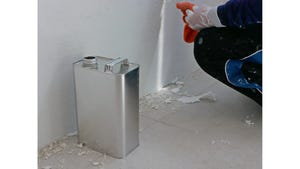Solving Segregation Problems
May 26, 2009
|
Dr. Kerry Johanson |
Segregation is a key issue affecting handling systems today. It is responsible for significant production loss, including downtime, in chemical and pharmaceutical plants. Understanding the role of segregation in processing is critical to proper operation and reliable production. The basic approach to solving a segregation problem includes: identifying the root cause; estimating the magnitude of potential segregation; estimating and predicting process velocities; analyzing the entire system; and modifying the process or material to eliminate segregation.
Engineers and vendors often approach segregation in an overly simplistic manner, suggesting a particular segregation problem can be cured using a universal piece of equipment. Such is not the case. However, segregation problems can be successfully handled by addressing the root cause. Many reasons for material segregation exist, but they all boil down to differences in key material properties. Fines sift through a matrix of coarse particles and deposit below the charge point. Air currents carry fines and deposit them in regions in the process equipment where gas velocities are insufficient to entrain fine particles. Differences in repose angle cause material separation during pile formation.
Differences in coefficients of restitution of particulate matter, as well as bulk elastic properties of a pile, change particle trajectory as they bounce down a pile surface, resulting in separation based on elastic behavior. Differences in wall friction angle cause different exit velocities, resulting in separation during process equipment fill-up. Electrostatic effects cause particles entering process equipment to migrate toward regions of opposing relative charge. Gas entrained in bulk material causes temporary material fluidization, while coarse particles impinging on the surface may penetrate the fluid layer and separate due to momentum effects. Those are only a few reasons for segregation. Any difference in bulk or particle scale property can cause separation. To solve segregation issues, one must identify various mechanisms that induce segregation. These mechanisms can be evaluated by measuring the segregation potential of your material. Note that one or several mechanisms may be causing segregation of your particular material.
The magnitude of potential segregation problems must also be identified. A material may be sensitive to segregation, but the process is operated in such a way that process events do not cause significant segregation magnitude. One common mistake made during segregation testing is that test conditions do not mimic actual process conditions. Incorrectly run segregation tests can, and often do, expose a particular material to excessive processing not realized in the actual system. Such tests may give positive segregation results, although the behavior causing particle separation does not occur in the process itself. Valid segregation testing must be conducted so as to mimic actual process conditions. Failure to do so results in erroneous segregation predictions.
Particle scale velocities in process equipment should be understood. Using current literature, vendors often suggest their equipment produces perfect, uniform mass flow and will handle any segregation problem. However, the ability to mitigate segregation effects depends on the segregation mechanism acting and the resulting segregation pattern. Some mechanisms produce top-to-bottom segregation profiles, while others produce radial segregation profiles.
Perfect uniform mass flow generally reduces radial segregation patterns, but increases process segregation of top-to-bottom patterns, exacerbating rather than mitigating segregation. When flow properties of bulk material are known, sound engineering principles can predict velocity profiles. These velocity profiles are used to estimate the effect of segregation during discharge.
Segregation is always systemwide. To solve a segregation issue, the entire system must be addressed. One particular segregation mechanism may produce a radial segregation pattern within the process, but upon material discharge cause a top-to-bottom pattern in the next surge or storage bin. The same segregation mechanism is responsible for both segregation profiles. Care must be exercised when retrofitting the process to avoid segregation. Finally, a small change in particle scale properties may alleviate segregation problems. Process segregation can be avoided, but this requires a full systematic approach.
Kerry Johanson has a PhD in chemical engineering and divides his time between researching at the University of Florida Particle Engineering Research Center and serving as chief operations officer for Material Flow Solutions Inc. (Gainesville, FL), a consulting firm he founded in 2001.
You May Also Like


